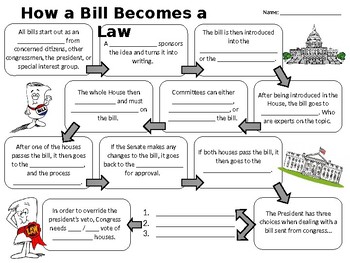39 how a bill becomes a law diagram
Second law of thermodynamics - Wikipedia The second law of thermodynamics is a physical law of thermodynamics about heat and loss in its conversion. It can be stated in various ways, the simplest being: Not all heat energy can be converted into work. The Second law of thermodynamics in other versions establishes the concept of entropy as a physical property of a thermodynamic system. sgr.virginia.edu › sites › sgrHOW A BILL BECOMES A LAW: VIRGINIA S LEGISLATIVE PROCESS HOW A BILL BECOMES A LAW: VIRGINIA’S LEGISLATIVE PROCESS Vetoed by Governor Approved/signed by Governor Approved/signed by Governor with amendment(s) Amendment(s) agreed to by House and
› enactment-of-a-lawEnactment of a Law - Congress.gov | Library of Congress Where the 10-day period extends beyond the date of the final adjournment of Congress, the president may, within that time approve and sign the bill, which thereby becomes a law. If, however, in such a case, the president does not approve and sign the bill before the expiration of the ten-day period, it fails to become a law.

How a bill becomes a law diagram
avalon.law.yale.edu › 19th_century › csa_csaAvalon Project - Constitution of the Confederate States ... (2) Every bill which shall have passed both Houses, shall, before it becomes a law, be presented to the President of the Confederate States; if he approve, he shall sign it; but if not, he shall return it, with his objections, to that House in which it shall have originated, who shall enter the objections at large on their journal, and proceed ... › sites › defaultHow a Bill Becomes a Law: A Step-By-Step Guide - ANCOR How a Bill Becomes a Law: A Step-By-Step Guide . Introduction of a Bill. Anyone may draft a bill, however, only members of Congress can introduce legislation, and by doing so become the sponsor(s). There are four basic types of legislation: Bills – Proposed legislation introduced in either the House or Senate that must be findanyanswer.com › who-can-introduce-a-bill-toWho can introduce a bill to Congress? - FindAnyAnswer.com May 19, 2020 · A bill is the draft of a legislative proposal, which becomes a law after receiving the approval of both the houses of the Parliament and the assent of the President. There are four types of bills -ordinary bill , money bill , finance bill and constitutional amendment bills .
How a bill becomes a law diagram. › legalblogsFindLaw Legal Blogs - FindLaw Law and Daily Life. Everyday life is full of challenges requiring basic legal knowledge. Our Law and Daily Life blog is here to answer questions about family issues, real estate, accidents and injuries, immigration, workplace law, and much more. › about › howHow does a bill become a law? - UK Parliament A Bill is a proposal for a new law, or a proposal to change an existing law, presented for debate before Parliament. A Bill can start in the Commons or the Lords and must be approved in the same form by both Houses before becoming an Act (law). This guide shows the passage of a Bill through ... findanyanswer.com › who-can-introduce-a-bill-toWho can introduce a bill to Congress? - FindAnyAnswer.com May 19, 2020 · A bill is the draft of a legislative proposal, which becomes a law after receiving the approval of both the houses of the Parliament and the assent of the President. There are four types of bills -ordinary bill , money bill , finance bill and constitutional amendment bills . › sites › defaultHow a Bill Becomes a Law: A Step-By-Step Guide - ANCOR How a Bill Becomes a Law: A Step-By-Step Guide . Introduction of a Bill. Anyone may draft a bill, however, only members of Congress can introduce legislation, and by doing so become the sponsor(s). There are four basic types of legislation: Bills – Proposed legislation introduced in either the House or Senate that must be
avalon.law.yale.edu › 19th_century › csa_csaAvalon Project - Constitution of the Confederate States ... (2) Every bill which shall have passed both Houses, shall, before it becomes a law, be presented to the President of the Confederate States; if he approve, he shall sign it; but if not, he shall return it, with his objections, to that House in which it shall have originated, who shall enter the objections at large on their journal, and proceed ...

0 Response to "39 how a bill becomes a law diagram"
Post a Comment